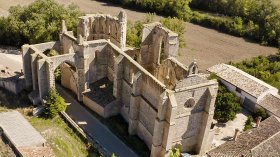
Create your own journey; Experience the best of Northern Spain at your own pace
This website uses its own and third-party cookies, for the proper functioning of the site and to generate usage statistics.
By continuing to browse we understand that you consent to our �ookie policy
Castilla y León is one of Spain's most iconic regions, where history comes alive in every corner. This land witnessed the union of the Catholic Monarchs in 1479, a pivotal moment that shaped the future of Spain. It was here that the final chapter of the Reconquista unfolded, and where Christopher Columbus received the funding for his 1492 voyage, leading to the discovery of the New World. Every city and village in Castilla y León carries the legacy of this remarkable past.
The region boasts a wealth of Roman and medieval heritage. From the ancient walls of León to the iconic aqueduct in Segovia, the grandeur of past civilizations remains vibrantly present. Gothic cathedrals, imposing castles, and beautifully preserved historic centers invite visitors to step back in time and explore the history that defined modern Spain.
Castilla y León offers far more than just its historical legacy. Travelers will discover a region where culture, nature, and world-class gastronomy combine seamlessly. Its cities and towns are cultural treasures, home to UNESCO World Heritage sites, centuries-old churches, and charming cobblestone streets. At the same time, its diverse landscapes provide endless opportunities for outdoor activities, from hiking through mountains and canyons to exploring its vast vineyards.
From the renowned Ribera del Duero wine region to the stunning Cantabrian mountains, Castilla y León invites you to explore its hidden gems. Each corner of the region has something unique to offer, whether it’s visiting wineries, touring medieval fortresses, or trekking through picturesque natural landscapes.
Authenticity: Discover the true essence of Spain, a region steeped in history and traditions that continue to thrive.
Exceptional Cuisine: Savor some of the finest wines and traditional dishes Spain has to offer, such as roasted lamb and Iberian ham.
The Camino de Santiago: Experience one of the world’s most famous pilgrimage routes, passing through some of the region’s most iconic cities.
UNESCO World Heritage: Explore six UNESCO sites, along with many other culturally and historically significant landmarks.
Adventure and Nature: Enjoy outdoor adventures in breathtaking landscapes, from hiking and cycling to wildlife safaris.
For food and wine lovers, Castilla y León is a must-visit destination. The region is home to some of Spain’s most prestigious wine appellations, including Ribera del Duero, Rueda, Toro, Bierzo, and Arribes. Visiting these wineries offers the chance to sample world-class wines, while the local cuisine—rooted in the region’s rich agricultural traditions—will delight even the most discerning palates. Don’t miss specialties like roasted lamb, suckling pig, and chorizo, which showcase the best of Castilian flavors.
The Camino de Santiago, one of Europe’s most celebrated pilgrimage routes, crosses the vast plains of Castilla y León, linking historic cities like León and Burgos. This route offers travelers a unique opportunity to not only engage in a spiritual journey but also to experience the region’s rich culture and history up close. Walking the Camino through Castilla y León is a truly unforgettable way to explore the heart of Spain.
Castilla y León is a cultural treasure trove, home to six UNESCO World Heritage sites, including the majestic Cathedral of Burgos, the ancient aqueduct of Segovia, and Salamanca’s historic old town. In addition to these, the region is dotted with countless other historical landmarks and cultural gems, such as the Roman mines of Las Médulas and the prehistoric archaeological sites of Atapuerca, offering a glimpse into Spain’s distant past.
If you’re passionate about nature and outdoor activities, Castilla y León is the perfect place to explore. The region’s diverse landscapes, from dramatic mountain ranges to deep river canyons, provide endless opportunities for adventure. Hiking, cycling, rafting, and wildlife spotting are just a few of the ways to experience the natural beauty of this region. It’s also home to a wide array of wildlife, including brown bears and Iberian wolves, making it an ideal destination for nature lovers.
The climate in Castilla y León varies throughout the year, with cold winters and hot summers in some areas. However, spring and autumn are the ideal times to visit, offering mild temperatures and stunning landscapes. The changing seasons also enhance the variety of experiences available, from rural tourism in the countryside to exploring the region’s historic cities.
Whether you’re passionate about history, culture, nature, or gastronomy, Castilla y León offers something for everyone. Crafting the perfect journey through this region means discovering a unique blend of experiences, each tailored to the preferences of the traveler. This is a destination where every itinerary can be customized to ensure an unforgettable experience, one that captures the very essence of Spain.
Located in the heart of León's charming old town, on a beautiful pedestrian street, our office is the perfect starting point for exploring the best of Castilla y León. As the headquarters of Spain is More, we leverage our deep-rooted knowledge of the region to craft personalized, authentic travel experiences tailored to your unique preferences.
Whether you're captivated by the rich cultural heritage, stunning natural landscapes, world-renowned wine regions, or historical cities like León, Segovia, and Salamanca, we are here to guide you every step of the way. Our local expertise ensures that your journey is thoughtfully designed to provide you with an immersive and unforgettable experience.
From exhilarating outdoor adventures in breathtaking landscapes to indulgent culinary tours that celebrate the region’s gastronomic excellence, each itinerary is curated to showcase the very best of Castilla y León. Get ready to embark on a journey that captures the essence of Spain, offering authenticity, adventure, and lasting memories.

Walking the Camino de Santiago de Compostela alone is the best way to live here and now.
The Iron Cross in Foncebadón: A Pilgrim's Symbol of Transformation

Convento de San Antón de Castrojeriz is a must-see

La Guardia Civil (Spanish police) has an app to improve safety for pilgrims on the camino. The only thing you have to do is download the app and switch on the 'geolocation' on your mobil...